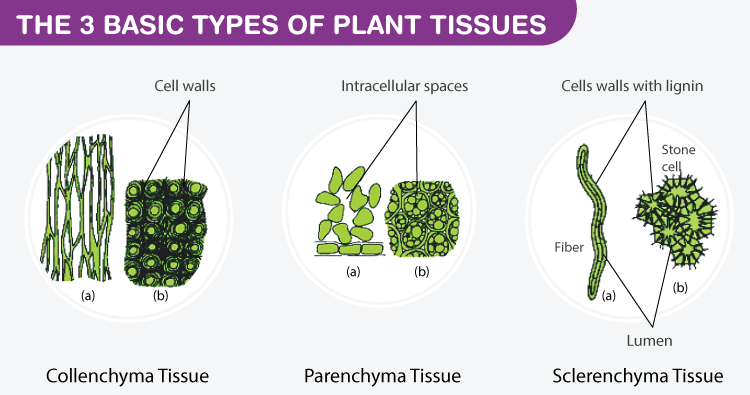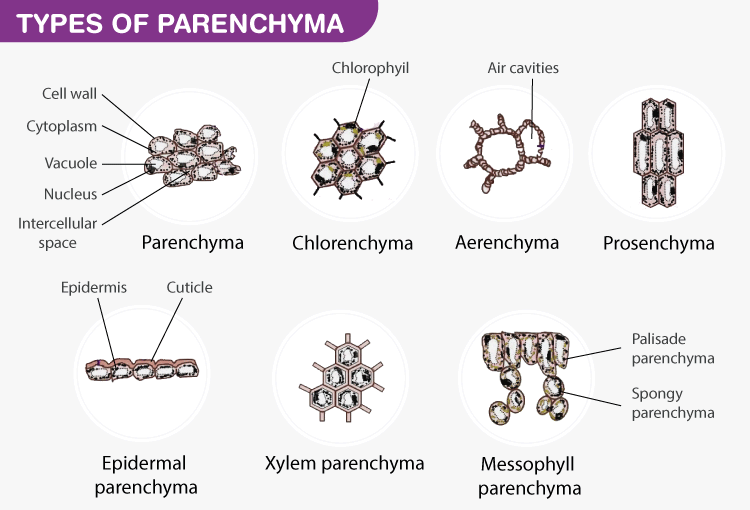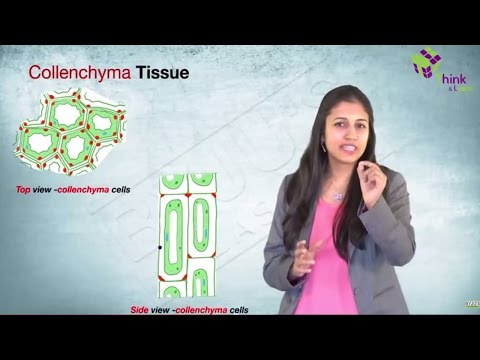Parenchyma is a type of simple permanent tissue that makes a major part of ground tissues in plants, where other tissues like vascular tissues are embedded. They are non-vascular and composed of simple, living and undifferentiated cells, which are modified to perform various functions.
Download Complete Chapter Notes of Anatomy of Flowering Plants
Download Now
The other simple permanent tissues are: –
- Collenchyma
- Sclerenchyma
Also see: NEET 2022 Answer Key PDF

Table of Contents
The main characteristics of parenchyma are:
- They are living permanent tissues that have the ability to divide at maturity and help in the regeneration and healing of wounds
- Parenchyma cells are the foundation of a plant as reproductive cells (spores, gametes) are parenchymatous in nature
- Single parenchyma cell of a zygote has an ability to develop into an entire plant. These cells are called “totipotent” cells
- Parenchyma cells occur in the form of continuous masses as homogeneous parenchyma tissues e.g. in pith and cortex of stems and roots, mesophyll of leaves, the flesh of succulent fruits and in the endosperm of seeds
- Parenchyma cells may be associated with other types of cells to form heterogeneous complex tissues such as parenchyma of xylem and phloem
- Parenchyma cells are essential for activities like photosynthesis, storage, secretion, assimilation, respiration, excretion and radial transport of water and solute
Also see: MCQs On Parenchyma Tissue
Structure of Parenchyma Cells
- It is a living cell
- It has a prominent nucleus and protoplast
- The cells of parenchyma are isodiametric or polyhedral in shape. They may be polygonal, oval, round or elongated
- These cells are closely packed or may have small intercellular space
- They are made up of thin cell wall made up of cellulose, hemicellulose
- Plasmodesmata join the cells of the parenchyma tissue
- They have several small vacuoles. In the older parenchyma, smaller vacuoles merge to become a large central vacuole, which may accumulate anthocyanin or tannins
- Water is abundant in the vacuoles of the parenchyma cells that act as a water reservoir
- Storage parenchyma cells may have thick xyloglucan walls e.g. in the endosperm of the date palm. The sugar is used during germination and walls become thin
- The parenchyma cells of flowers and fruits contain chromoplasts
- Parenchyma cells may have a thick lignified wall that makes it difficult to differentiate it from sclerenchyma
- Hydraulic property of cells gives the parenchyma its mechanical strength
- Chloroplasts are present in the parenchyma cells that are specified to perform photosynthesis
- The parenchyma cells which perform a secretory function, have dense protoplasm that is rich in ribosomes, Golgi bodies and a highly developed endoplasmic reticulum
Also check:
Types of Parenchyma Cells
Parenchyma cells can be categorised based on their structure, location and functions performed. The main parenchyma tissues are:

- Chlorenchyma:
Cells which have chloroplast and perform photosynthesis
-
-
- The mesophyll cells in leaves which differentiate into palisade and spongy cells
- In the other green parts of the plants like stems, sepal etc.
- Transfer Cells: They play an important role in the transport of solutes over short distances.
- They have cell wall ingrowths, which greatly increase the surface area of the plasma membrane
- Sucrose is transported across the membrane through a proton/sucrose co-transport mechanism
- These are found in the areas of absorption and secretion in plants like nectaries, salt glands and in carnivorous plants
- Vascular Parenchyma: The parenchyma cells which are associated with vascular tissues. These are of two types:
- Phloem Parenchyma:
-
It is made up of elongated, tapering and cylindrical cells having dense cytoplasm.
-
- Plasmodesmata connections occur between the cells through pits in the walls
- It stores food and other materials like resins, latex and mucilage
- Absent in monocotyledons
-
-
- Xylem Parenchyma:
It is made up of thin-walled cells. The cell wall is made up of cellulose.
-
- It stores food materials like starch, fats and other substances such as tannins and crystals
- Radial conduction of water takes place by ray parenchymatous cells
- In the water-stress condition, they help in preventing damage to tracheids and vessels
- Storage Parenchyma: These store various substances like water, starch, proteins etc. They act as a food and water reservoir.
- Stored protein is a good source of nitrogen for plants
- In starch storing cells like in potato tubers, the endosperm of cereals and cotyledons, abundant starch-containing amyloplasts are present
- Parenchyma cells may be specialised as a water storage tissue in succulent plants such as Cactaceae, aloe, agave, etc.
- In the underground storage like in potato tuber, it can initiate the shoot growth and provide moisture for the initial growth of growing parts
- Prosenchyma: These are fibre-like elongated cells, which are thick-walled and provide rigidity and strength to the plant
- Aerenchyma:
They contain very large intercellular spaces. These are present in aquatic plants.
- Aerenchyma helps in the buoyancy of the floating plants
- It helps in the respiration and provides sufficient oxygen to the aquatic plants
- The aerenchyma formation takes place naturally in the roots of rice (Oryza sativa)
- The aerenchyma of leaves and stems of aquatic plants are large longitudinal cells with air spaces or lacunae, which are gas-filled
- Aerenchymatous cells are often water-filled
- Aerenchyma cells are continuous from shoots to roots and help in diffusion of air from leaves to roots. It helps in maintaining sufficient oxygen levels for respiration.
- The excess oxygen consumed, diffuses out from the roots into the soil atmosphere
- They help in creating locally aerobic rhizosphere in the anaerobic soil
- Epidermis Parenchyma: It is found in the epidermis of the leaves of some gymnosperms.
- These have cutinised cell wall
- No intercellular spaces
- Cutin layer on the outer surface of epidermis reduces transpiration and counters the environmental stress
- Have many spiny projections for the protection
- Conjunctive Parenchyma: This type of parenchyma is present in the root system.
- Non-cutinised, with the thin cell wall, present on the outer layer of the young parts of the root. It is known as epiblema or piliferous layer
- It may form tubular outgrowths know as root hair
- The main function is to absorb water and minerals from the soil
Functions of Parenchyma cells
Parenchyma cells form the ground tissue of plants. Parenchyma tissues perform various important functions:
- Storage: Parenchyma cells have large intercellular space which is ideal for storage
- High amount of starch is present in the tubers of potato and cassava
- These can store water, fats, oil droplets, and ergastic substances
- Store water and act as a water reservoir
- Transport: Parenchyma cells transport nutrients and other chemicals
- Transfer cells have outgrowth for increasing absorption surface
- The xylem parenchyma helps in radial transportation of water and minerals
- Some cells transport light from the surface to underground cells
- Photosynthesis: Chlorenchyma present in the mesophyll and the other green parts of the plant, have chloroplasts and perform photosynthesis
- Gas Exchange: Aerenchyma cells help in the gas exchange
- Protection: In gymnosperms, the parenchymatous cell have spiny projections that help in the protection from predators
- Totipotent: Parenchyma cells have an ability to transform to the other types of cells and act as a precursor for other types of cells
- Buoyancy: Aerenchyma present in aquatic plants have air sacs that help in floating
- Cuticle present on epidermis helps in reducing transpiration in water stress condition
- Thick-walled parenchyma cells provide mechanical strength to the plant
- Healing and regeneration: Parenchyma cells that retain their ability to divide even on maturity help in regeneration and wound healing. Tyloses present in the xylem parenchyma help in preventing damage to vascular tissues in the condition of drought.
Also Check:
NEET Flashcards: Morphology Of Flowering Plants
NEET Flashcards: Anatomy Of Flowering Plants
NEET Flashcards: Photosynthesis In Higher Plants
NEET Flashcards: Respiration In Plants
NEET Flashcards: Plant Growth And Development
Recommended Video:


These notes are really very detailed and i like it very much
Very good and detailed explanation!
The absolute perfect information for projects
#learning with Byjus
It is really good video lessons in Byjus premium.
It is really good, I was given the exact answer I needed. Thank you